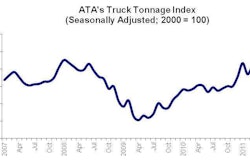Saia Inc. on Tuesday, June 28, announced the findings of its 2011 National Trends in Small to Medium-sized Businesses, a nationwide survey of U.S. executives on their motivations and beliefs about economic conditions, budgets and supply chains. The vast majority (65 percent) of U.S. executives say the economy is their number one concern, followed by fuel costs (23 percent) and health insurance (15 percent).
“Small to medium-sized businesses are the backbone of our economy,” says Rick O’Dell, president and chief executive officer of Johns Creek, Ga.-based Saia. “Normally, you would expect business leaders to be more upbeat coming out of a downturn like we recently experienced. I am encouraged by several of the survey’s findings including those regarding staffing and supply chain expenditures.”More than one-third (39 percent) of those surveyed say capital expenditures will be the same in 2011 as in 2010. Capital expenditures for 2011 will be higher according to one-third (33 percent) of business executives. More than one-quarter (28 percent) say capital expenditures will be less in 2011 than in 2010.
Supporting their concern of uncertainty, nearly three-quarters (72 percent) of executives say they plan on maintaining the same number of employees for the next 12 months as they have today. Seventeen percent of those surveyed say their company plans to increase the number of employees in the next 12 months, while 11 percent say they plan to reduce their current staffing levels.
“About one in 10 small to midsize businesses are changing their inventory practices as a direct result of the catastrophes in Japan earlier this year,” says O’Dell. “Nearly two-thirds of those surveyed say they do not have a contingency plan in place to handle inventory issues during a business interruption or emergency event. With an increased number of natural disasters, both abroad and here in the U.S. in recent months, businesses need to consider developing contingency plans.”
In the event of a major business interruption or emergency event, respondents say their company:
• Has alternative suppliers for key materials and parts (38 percent);
• Maintains safety stock (36 percent);
• Has a business continuity plan already in place (25 percent);
• Plans for contingent shipping arrangements (20 percent);
• Accelerates shipments as needed (21 percent);
• Carries business interruption insurance (17 percent);
• Implements a crisis communications plan with key vendors (14 percent);
• Monitors product transportation paths (13 percent); and
• Taps into onsite emergency preparedness plans and onsite tools (8 percent).
“Even with the concern many executives are feeling, not all companies are cutting costs at every corner,” said O’Dell. “In fact, when it comes to their supply chain, many companies are increasing their budgets this year. Nearly half of those surveyed say they are increasing their less-than-truckload budget.”
With regard to shipping, executives say their 2011 budgets are increasing when it comes to:
• Less-than-truckload (46 percent);
• Truckload (20 percent);
• Expedited shipping (19 percent);
• Guaranteed shipping (18 percent);
• Distribution (15 percent);
• International (13 percent); and
• 3PL (2 percent).
When it comes to carrier measurements, executives were asked which measurement they valued most. On-time delivery leads the way hands down (65 percent) followed by pick-up performance (11 percent) and claims-free service (9 percent).
Nearly half of all executives (41 percent) say they are unfamiliar with the federal government’s Compliance Safety Accountability program. Of those expressing familiarity, more than half (54 percent) are concerned the program will impact their supply chain.
Nearly half of those surveyed (49 percent) say their companies offer a recycling program for multiple items, whether it is paper products, plastic, batteries, glass or aluminum. Thirty-one percent say their company employs faxing via e-mail to eliminate paper, and 23 percent say their company offers a recycling program, but only for paper products. Other eco-friendly practices include:
• Ceramic or other plate/utensils in the kitchen or break room, eliminating the need for plastic (13 percent);
• Telecommuting (11 percent);
• Composting (7 percent);
• Community programs focused on green initiatives (4 percent); and
• Cafeteria sourcing local foods when available (3 percent).
While 50 percent of business executives say “how green” a vendor is can play a role in their decision to work with that vendor, nearly one-third (30 percent) say their company is not green at all.
For more information on the 2011 National Trends in Small to Medium-sized Businesses study report, go to www.saia.com/v2/studylink.aspx.














